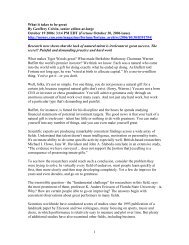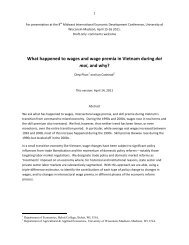Berndt, E. and D. Wood
Berndt, E. and D. Wood
Berndt, E. and D. Wood
You also want an ePaper? Increase the reach of your titles
YUMPU automatically turns print PDFs into web optimized ePapers that Google loves.
The Review of Economics <strong>and</strong> Statistics<br />
VOL. LVII AUGUST 1975 NUMBER 3<br />
TECHNOLOGY, PRICES, AND THE DERIVED<br />
DEMAND FOR ENERGY<br />
I. Introduction<br />
INDUSTRIAL dem<strong>and</strong> for energy is essen-<br />
tially a derived dem<strong>and</strong>: the firm's dem<strong>and</strong><br />
for energy as an input is derived from the de-<br />
m<strong>and</strong> for the firm's output. Inputs other than<br />
energy typically also enter the firm's production<br />
process. Since firms tend to choose that bundle<br />
of inputs which minimizes the total cost of pro-<br />
ducing a given level of output, the derived de-<br />
m<strong>and</strong> for inputs, including energy, depends on<br />
the level of output, the substitution possibilities<br />
among inputs allowed by the production tech-<br />
nology, <strong>and</strong> the relative prices of all inputs.<br />
Empirical studies typically have not simulta-<br />
neously considered the derived dem<strong>and</strong> for en-<br />
ergy <strong>and</strong> nonenergy inputs. Studies of industrial<br />
energy dem<strong>and</strong> have been restricted in one of<br />
two ways: (1) by focussing attention solely on<br />
the level of output <strong>and</strong> ignoring input prices<br />
(Darmstadter et al. 1971), Dupree <strong>and</strong> West<br />
(1972), Morrison <strong>and</strong> Readling (1968), Na-<br />
tional Energy Board (1971), National Petro-<br />
leum Council (1971) (Schurr et al. 1960), or<br />
(2) by confining the analysis to output <strong>and</strong> the<br />
dem<strong>and</strong> response of some particular energy<br />
type to a change in its own price <strong>and</strong> perhaps<br />
that of close energy substitutes, but neglecting<br />
the prices of all nonenergy inputs (Anderson<br />
1971), Baxter <strong>and</strong> Rees (1968), Mount, Chap-<br />
Received for publication March 26, 1974. Revision ac-<br />
cepted for publication December 30, 1974.<br />
* The authors are indebted to G. Chris Archibald, W.<br />
Erwin Diewert, David L. Dorenfeld, John H. Helliwell,<br />
Dale W. Jorgenson, L. J. Lau, <strong>and</strong> N. E. Savin for their<br />
helpful comments. The views expressed in this paper, how-<br />
ever, are those of the authors. Mr. <strong>Berndt</strong> acknowledges<br />
research support from the University of British Columbia<br />
<strong>and</strong> the Ford Foundation Energy Policy Project. Both au-<br />
thors acknowledge the research assistance of Eli Appel-<br />
baum, S<strong>and</strong>ra Dean, Bruce Kendall, <strong>and</strong> Muhammad<br />
Khalid.<br />
Ernst R. <strong>Berndt</strong> <strong>and</strong> David 0. <strong>Wood</strong>*<br />
man, <strong>and</strong> Tyrrell (1973). In a similar fashion,<br />
empirical studies of dem<strong>and</strong> for nonenergy in-<br />
puts have excluded from their concern the role<br />
of energy prices. For example, the voluminous<br />
literature on determinants of investment behav-<br />
ior typically either (i) restricts attention to<br />
changes in output <strong>and</strong> ignores all input prices<br />
(the "accelerator" models), or (ii) exp<strong>and</strong>s the<br />
analysis to output <strong>and</strong> the prices of capital <strong>and</strong><br />
labor services, but ignores the possible role of<br />
all intermediate inputs including energy (the<br />
"neoclassical" models). To our knowledge, no<br />
empirical study has explicitly investigated<br />
cross-substitution possibilities between energy<br />
<strong>and</strong> nonenergy inputs.1<br />
The absence of studies on substitution possi-<br />
bilities between energy <strong>and</strong> nonenergy inputs<br />
becomes particularly apparent if one is inter-<br />
ested in deriving implications of increasingly<br />
scarce <strong>and</strong> higher priced energy inputs. Con-<br />
sider the effect of higher priced energy on cor-<br />
porate investment behavior. If energy <strong>and</strong> cap-<br />
ital are substitutable, ceteris paribus, then<br />
higher priced energy will increase the dem<strong>and</strong><br />
for new capital goods. If energy <strong>and</strong> capital are<br />
complementary, however, then ceteris paribus,<br />
higher priced energy will dampen the dem<strong>and</strong><br />
for energy <strong>and</strong> the dem<strong>and</strong> for new plant <strong>and</strong><br />
equipment. More generally, if it were found<br />
that possibilities for substitution between en-<br />
ergy <strong>and</strong> nonenergy inputs are extremely lim-<br />
ited, then we might expect that the adjustment<br />
by industry to higher priced energy will be<br />
somewhat difficult, that unit cost may rise con-<br />
siderably, that the composition of output may<br />
shift away from energy intensive products, <strong>and</strong><br />
1 Parks (1971) has investigated substitution possibilities<br />
between capital, labor, <strong>and</strong> three intermediate goods, but<br />
does not specify energy as a separate input.<br />
[ 259 ]







